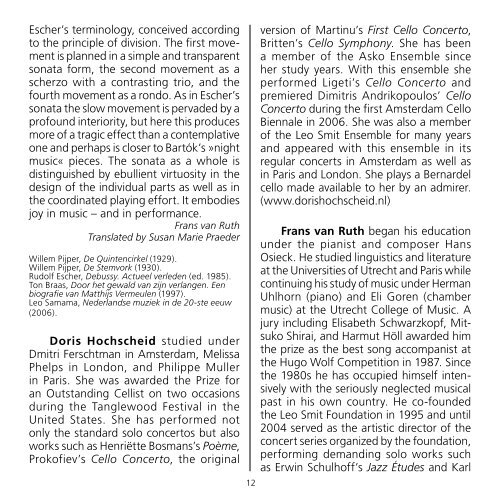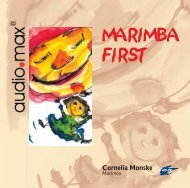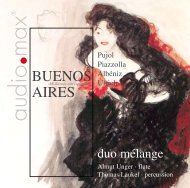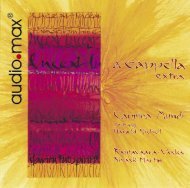Dutch Cello Sonatas - MDG Dabringhaus und Grimm
Dutch Cello Sonatas - MDG Dabringhaus und Grimm
Dutch Cello Sonatas - MDG Dabringhaus und Grimm
Sie wollen auch ein ePaper? Erhöhen Sie die Reichweite Ihrer Titel.
YUMPU macht aus Druck-PDFs automatisch weboptimierte ePaper, die Google liebt.
Escher’s terminology, conceived according<br />
to the principle of division. The first movement<br />
is planned in a simple and transparent<br />
sonata form, the second movement as a<br />
scherzo with a contrasting trio, and the<br />
fourth movement as a rondo. As in Escher’s<br />
sonata the slow movement is pervaded by a<br />
profo<strong>und</strong> interiority, but here this produces<br />
more of a tragic effect than a contemplative<br />
one and perhaps is closer to Bartók’s »night<br />
music« pieces. The sonata as a whole is<br />
distinguished by ebullient virtuosity in the<br />
design of the individual parts as well as in<br />
the coordinated playing effort. It embodies<br />
joy in music – and in performance.<br />
Frans van Ruth<br />
Translated by Susan Marie Praeder<br />
Willem Pijper, De Quintencirkel (1929).<br />
Willem Pijper, De Stemvork (1930).<br />
Rudolf Escher, Debussy. Actueel verleden (ed. 1985).<br />
Ton Braas, Door het gewald van zijn verlangen. Een<br />
biografie van Matthijs Vermeulen (1997).<br />
Leo Samama, Nederlandse muziek in de 20-ste eeuw<br />
(2006).<br />
Doris Hochscheid studied <strong>und</strong>er<br />
Dmitri Ferschtman in Amsterdam, Melissa<br />
Phelps in London, and Philippe Muller<br />
in Paris. She was awarded the Prize for<br />
an Outstanding Cellist on two occasions<br />
during the Tanglewood Festival in the<br />
United States. She has performed not<br />
only the standard solo concertos but also<br />
works such as Henriëtte Bosmans’s Poème,<br />
Prokofiev’s <strong>Cello</strong> Concerto, the original<br />
version of Martinu’s First <strong>Cello</strong> Concerto,<br />
Britten’s <strong>Cello</strong> Symphony. She has been<br />
a member of the Asko Ensemble since<br />
her study years. With this ensemble she<br />
performed Ligeti’s <strong>Cello</strong> Concerto and<br />
premiered Dimitris Andrikopoulos’ <strong>Cello</strong><br />
Concerto during the first Amsterdam <strong>Cello</strong><br />
Biennale in 2006. She was also a member<br />
of the Leo Smit Ensemble for many years<br />
and appeared with this ensemble in its<br />
regular concerts in Amsterdam as well as<br />
in Paris and London. She plays a Bernardel<br />
cello made available to her by an admirer.<br />
(www.dorishochscheid.nl)<br />
Frans van Ruth began his education<br />
<strong>und</strong>er the pianist and composer Hans<br />
Osieck. He studied linguistics and literature<br />
at the Universities of Utrecht and Paris while<br />
continuing his study of music <strong>und</strong>er Herman<br />
Uhlhorn (piano) and Eli Goren (chamber<br />
music) at the Utrecht College of Music. A<br />
jury including Elisabeth Schwarzkopf, Mitsuko<br />
Shirai, and Harmut Höll awarded him<br />
the prize as the best song accompanist at<br />
the Hugo Wolf Competition in 1987. Since<br />
the 1980s he has occupied himself intensively<br />
with the seriously neglected musical<br />
past in his own country. He co-fo<strong>und</strong>ed<br />
the Leo Smit Fo<strong>und</strong>ation in 1995 and until<br />
2004 served as the artistic director of the<br />
concert series organized by the fo<strong>und</strong>ation,<br />
performing demanding solo works such<br />
as Erwin Schulhoff’s Jazz Études and Karl<br />
Amadeus Hartmann’s Second Piano Sonata<br />
in connection with these concerts. (www.<br />
fransvanruth.nl)<br />
Both musicians teach at the Conservatorium<br />
van Amsterdam (Amsterdam<br />
School of Arts).<br />
Over the years Doris Hochscheid and<br />
Frans van Ruth have mastered a common<br />
repertoire of almost a h<strong>und</strong>red compositions<br />
ranging from the gamba sonatas of<br />
Johann Sebastian Bach to a steadily increasing<br />
number of works composed especially<br />
for them.<br />
They have been praised for their<br />
remarkable program design bringing<br />
together Mendelssohn’s Second <strong>Cello</strong><br />
Sonata and Grützmacher’s arrangement<br />
of Schumann’s Second Violin Sonata, for<br />
their ebullient presentation of the youthful<br />
Sonata by Richard Strauss, for their colorful<br />
interpretation of Debussy’s Sonata and for<br />
their illuminating <strong>und</strong>erstanding of the lateromantic<br />
Sonata by the Franck pupil Louis<br />
Vierne. They also respond with complete<br />
commitment to the challenge posed by<br />
contemporary music. Cordes invisibles by<br />
Roderik de Man, a composition awarded<br />
a first prize in the competition for electroacoustic<br />
music in Bourges in 2005, numbers<br />
among the compositions written for them.<br />
They have also premiered Two Vocalises<br />
by Mark Anthony Turnage (Amsterdam,<br />
2001), and the Second Sonata of Krzysztof<br />
Meyer (Kiev Music Festival, 2006). During<br />
12 13<br />
the Poznán Music Spring 2008 they presented<br />
a program featuring new music from<br />
Poland and the Netherlands.<br />
Together with the violinist Jacobien<br />
Rozemond and the violist Elisabeth Smalt<br />
they form the Amsterdam Bridge Ensemble<br />
praised in the German press for its »virtuosity<br />
of the passions.« The ensemble above<br />
all would like to build bridges between the<br />
romantic and modern eras but in no way<br />
neglects the classical period or contemporary<br />
music. Its compact disc featuring<br />
works by René Samson – including his<br />
<strong>Cello</strong> Sonata – was awarded the highest<br />
score (ten points) in the <strong>Dutch</strong> music<br />
journal Luister.<br />
Doris Hochscheid and Frans van Ruth<br />
performed Matthijs Vermeulen’s Second<br />
<strong>Cello</strong> Sonata in 2003 on the occasion of<br />
the presentation of a new edition of his<br />
chamber music and his First <strong>Cello</strong> Sonata<br />
in 2006 on the occasion of the unveiling<br />
of a bust in his honor in Helmond, his<br />
birthplace. A compact disc released in 2003<br />
with works by Henriëtte Bosmans and Lex<br />
van Delden was termed »passionate« and<br />
»of an extraordinary level« in the <strong>Dutch</strong><br />
press. All of this led to the fo<strong>und</strong>ing of the<br />
<strong>Dutch</strong> <strong>Cello</strong> Sonata Fo<strong>und</strong>ation in 2007.<br />
One of the activities of the fo<strong>und</strong>ation<br />
– in cooperation with <strong>MDG</strong> – will be an<br />
extensive CD project documenting <strong>Dutch</strong><br />
music for violoncello and piano. (www.<br />
cellosonate.nl)







